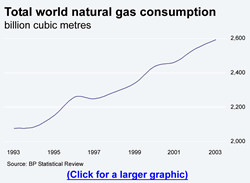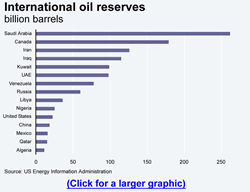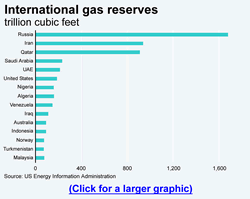INTERNATIONAL: LNG industry set for expansion
The capital cost of new LNG projects has fallen, while the price garnered at the point of consumption has risen. Furthermore, demand for natural gas is growing steadily, while regionally based consumer markets are seeing local production hit or pass peak production. LNG provides the means to deliver otherwise unreachable gas reserves to the world's major consuming economies. This shift in the dynamics of the natural gas market will further commoditise natural gas globally.
Analysis
The liquefied natural gas (LNG) industry is set for a large and sustained expansion as improved technology has reduced the cost of transporting formerly stranded gas reserves in liquid form.
Key assumptions
- Cost reductions both in terms of capital and running costs are likely over the next ten to 15 years as the industry expands.
- Greater use of LNG in the long-term, would, for the world's major consumers, increase dependence on Russian energy supplies and maintain global dependence on the Middle East, with Iran and Qatar emerging in more powerful positions as the key producers of the swing barrel.
- Demand-side technology improvements unrelated to the cost of producing LNG, particularly the growth in combined cycle gas turbine electricity generation, has significantly boosted demand for natural gas over and above alternative energy sources.
Concurrently, regionally based natural gas markets, hitherto restricted by the physical and economic limitations of conventional pipelines, have reached peak production in terms of nearby reserves. Demand for natural gas continues to grow -- owing to its advantages over other energy sources, causing a shortfall in supply -- which is best met by LNG.
LNG 'ABC' . There are three key stages in the LNG production process:
- LNG is natural gas cooled to minus 260 degrees. This reduces its volume by a factor of 610 and allows it to be transported in specially designed ships to consumer markets.
- The natural gas must be processed to remove any impurities before liquefaction, as these will solidify in the cooling process. However, processing before liquefaction should produce a more standardised product, enhancing its spot market deliverability.
- Transportation is a capital intensive process, requiring a liquefaction plant, dedicated specialised transport and regasification at a point linking into a consuming market's pipeline network. As a result, the majority of LNG production has been, and continues to be, sold on long-term forward contracts, stretching up to 25 years in length. However, increasingly, LNG projects are producing additional output, creating the development of a spot market in LNG cargoes.
Liquefaction. The costs of liquefaction have fallen as competition has re-emerged in the industry:
- Commercial players. Following the first period of investment in LNG technology and plants in the 1960s and early 1970s, four firms competed with different processes that developed by Air Products and Chemicals (APCI) became the standard technology. However, by 1999, Phillips/Bechtel had re-entered the market, followed by Statoil-Linde and Shell Dual with Mixed Refrigerants processes. Studies of the different liquefaction processes suggest there is no single one that is substantially more efficient than the others. Rather, each technology can be competitive within a certain range of train sizes.
- Lower costs. Increased competition has driven down costs by reducing the mark-up made by plant suppliers and/or technological efficiencies and experience gains. Experience gains may be relatively unimportant as a single technology dominated until the late 1990s, and the development of alternatives has occurred over too short a time period, and with too limited a volume of construction, for these gains to be obvious. This suggests that cost reductions are likely, both in terms of capital and running costs, over the next ten to 15 years as the industry expands. Despite the industry being almost 50 years old, it has moved only a small way down the construction cost experience curve, and it would appear that after a period of relative stagnation in development, the scale of new projects is again creating substantial gains in experience and organisational learning.
- Reduced energy. One of the most marked efficiencies has been the reduction in energy input needed to liquefy the gas:
- The first LNG plant in Arzew, Algeria built in the 1960s required 509 kilowatt-hours/tonne LNG, while current installations need 250-330 kilowatt-hours/tonne LNG.
- New projects, such as the plant being built in Melkoye to process and liquefy the gas from Statoil's Snovhit field in the Barents Sea expect to reduce this cost still further.
- Economies of scale. LNG train capacity has increased from around 1.5 million tonnes per year in the 1970s to between 3 to 4 million tonnes per year in new construction projects. As liquefaction is estimated to account for 40-50% of the capital costs of the total LNG chain, cheaper processes have been a major factor underpinning the viability of new LNG projects.
Regasification. New commercial capacity is moving towards more efficient unloading processes, involving offshore terminals with storage and regasification facilities, which are then linked by conventional pipelines to domestic gas grids. A cryogenic liquid storage LNG terminal will typically use gas-fired vaporisers to take LNG from storage, warm it and inject it into pipelines. However, new technologies such as seawater heat transfer avoid the use of natural gas in the process.
In January, Daewoo Shipbuilding and Marine Engineering delivered the Excelsior, the world's first LNG regasification vessel, which can supply regasified gas without the need for onshore storage facilities. The Excelsior has a capacity of 138,000 million cubic metres (cm3) and cost about 200 million dollars -- 30 million more than a standard LNG vessel of a similar size. At the end of 2003, there were 151 LNG tankers with a combined capacity of 17.4 cm3 of LNG, equivalent to 366 billion cubic feet (bcf) of natural gas. There were also 55 tankers under construction, suggesting capacity will increase 44% to 25.1 million cm3 of LNG by 2006, equivalent to 527 bcf of natural gas. The expansion in ship construction is again likely to bring economies of scale.
Pricing. While the capital cost of developing LNG operations has fallen, the value of the end product at the point of consumption has risen:
- LNG prices tend to follow oil prices, as natural gas can be substituted for oil in various uses such as electricity generation, heating buildings and as a feedstock for the chemical industry. Gas to liquids technology and the search for alternative fuels also raises the possibility of natural gas becoming a substitute to oil for fuel transport.
- As a result, the recent upward shift in oil prices (see INTERNATIONAL: Iraq oil output stuck despite polls - February 7, 2005) has been mirrored across the energy complex, and the perception that this shift is long-term has improved the economics of LNG developments.
- Demand-side technology improvements unrelated to the cost of producing LNG, particularly the growth in combined cycle gas turbine electricity generation, has significantly boosted demand for natural gas over and above alternative energy sources.
Demand for LNG. The major consuming countries developing LNG infrastructure are looking at LNG not just in terms of diversification and cleaner energy production, but because they are moving towards, or have already developed, an energy supply deficit. Therefore, LNG is attractive to a variety of consuming nations, particularly:
- those without significant reserves, seeking reduced oil dependence, such as Japan and South Korea, but also some of the main European economies;
- those whose indigenous industries have hit or passed peak output, such as the United States and United Kingdom, which have highly developed gas delivery infrastructure but are increasingly net importers; and
- developing economies which are energy hungry owing to economic growth -- the principal examples being China and India, both of which have relatively under-developed delivery infrastructure but potential for huge growth in the number of end-users.
Expansion on the demand side is dynamic:
- The largest and most long-standing importers of LNG -- Japan, South Korea and Taiwan -- are all steadily expanding their regasification capacities.
- China, India and the United Kingdom are all building terminals to receive LNG.
- The United States, in 2002, imported 229 bcf of LNG, about 4% of the world total, and had four LNG import terminals with a combined total regasification capacity of about 1,200 bcf per year. LNG could rise from 2% of US gas consumption, to as much as 8% as early as 2010, according to the Energy Information Administration (EIA).
- In Europe, gas demand rose 3.3% to 458.3 bcm in 2004, while the number of end-users has grown to 240 million, according to Eurogas estimates. Eurogas says natural gas currently meets over 20% of primary energy needs for the European Union, and that this is likely to rise to over 27% by 2020.
- The United Kingdom became a net importer of gas in 2004 for the first time since 1996; despite forecasts predicting this would occur in 2006. Imports are expected to exceed domestic production by 2012.
Supply of LNG. LNG production will help to meet global demand for natural gas:
-
Concentration concerns. Proponents of LNG often argue that it is a means of diversifying away from oil dependence and the main oil exporters. However, the distribution of world gas reserves is not substantially different from oil, and brings with it a similar set of political and security concerns:
- The countries with the largest reserves are Russia, which holds about 27% of proven world reserves, followed by Iran with just over 15% of the world's total and Qatar with just under 15%.
- The next five largest with export capacity have reserves ranging from 3.80% down to 2.36% and are Saudi Arabia, the UAE, Nigeria, Algeria and Venezuela.
- The total for OPEC and Russia is just over three-quarters of proven world gas reserves.
Greater use of LNG in the long-term, would, for the world's major consumers, increase dependence on Russian energy supplies and maintain global dependence on the Middle East, with Iran and Qatar emerging in more powerful positions as the key producers of the swing barrel.
-
New suppliers. In the medium term, LNG exporters are going to be more diverse than the concentration of reserves might suggest. LNG exporters, until 1999, were predominantly concentrated in the Pacific basin, exporting to Japan and South Korea, for whom LNG makes up almost the whole of the two countries' natural gas consumption. However, the number of exporting countries and the destinations of the LNG exports are expanding rapidly:
- LNG trains came on-stream in Trinidad and Tobago and Malaysia in 2003.
-
Egypt is the latest country to join the ranks of LNG exporters (bringing the total number to 15, from nine in 1997). The Spanish Egyptian Gas Company's (SEGAS) LNG complex in Damietta came on-stream in fourth-quarter 2004 and will export LNG to the Spanish market via a new receiving terminal at Sagunto, Spain.
-
Iran, which has the world's second largest reserves of natural gas, has three projects underway. Combined, they have a potential capacity of 24 million tonnes per year, which is equivalent to 1.15 trillion cubic feet (tcf) of supply.
- Output capacity. According to the US Energy Information Administration, LNG output expressed in natural gas equivalent terms has risen from 4 tcf in 1997 to 5.4 tcf in 2002, 6.6 tcf in 2003, while new projects and expansions to existing capacity will extend output to 9.4 tcf by 2007, which represents about 10% of 2002 natural gas consumption. Of this, about 3.3 tcf is expected to be in the Atlantic basin.
Tradeability. The rising number of consuming and producing parties is likely to provide trading opportunities, as the physical product will be deliverable against the two main futures contracts:
- The London-based International Petroleum Exchange's natural gas contract, unlike its crude oil contract, accepts direct physical delivery within the UK national gas grid at the National Balancing Point if futures positions are not closed prior to expiry.
- In the United States, Nymex's natural gas contract allows physical delivery based on delivery at the Henry Hub in Louisiana.
LNG as a tradeable commodity is emerging into a fully-fledged financial complex, and will add to that complex by providing a physical arbitrage between different regional markets.
Environmental impact. Proponents of natural gas have been very successful in marketing it as a clean alternative to oil. However, burning natural gas produces large amounts of the greenhouse gas C02, thus LNG and increased natural gas usage is less harmful to the environment only where it displaces dirtier substitutes such as coal or oil firing processes. Burning unprocessed gas to run a liquefaction plant emits local pollutants, depending on the impurities of the gas at the specific location. High sulphur content can require expensive treatment and removal facilities, adding to capital costs.
However, natural gas might provide a cleaner interim stepping stone to a hydrogen economy. Its limited reserve base, though undoubtedly large, suggests a limited period of expansion, similar to oil, which suits this scenario. However, if methane hydrates become commercially exploitable, then proven gas reserves would multiply, making CH4 a long-term hydrocarbon resource (see INTERNATIONAL: Vast reserves fuel methane research - May 30, 2003), its abundance potentially holding back the development of cleaner energy sources.
Conclusion
The transportation of formerly stranded gas has become economically viable. Therefore, the LNG industry is set for a large and sustained expansion as improved technology has reduced the cost of transporting formerly stranded gas reserves in liquid form. While neither a political nor an environmental panacea, LNG offers a global commodity that can meet the growth in demand for natural gas.


